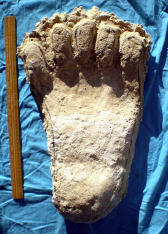In an effort to gather as much scientific evidence as possible, in 2000 we launched our ongoing “Operation Yowie” project. Since then we have carried out many field investigations over a wide area of the eastern Australian mountain ranges, in the course of which a number of new Yowie/Homo erectus footprints have been found and cast, published newspaper articles, done radio interviews and lectured on our findings. All this has resulted in a wide-scale public response providing us with plenty of new reports of sightings, footprint finds and new leads on where to carry out future field investigations.
It is now fifty years since that day in March 1957, at the age of 14 that I picked up in the library at Liverpool Boys High School, a little worn paperback on Aboriginal myths and legends and read my first story of the “Hairy Man”. It was also the year that I began collecting reports on Australian mystery animals. Little did I realise at that time that I was creating Australian Relict Hominid and Cryptozoology research, as I began my schoolboy research into the Yowie and mystery animals.
As I had been collecting insects and other zoological specimens since the age of seven, I already had the beginnings of what was to become the largest privately owned natural science collection in Australia and which would in the years ahead be exhibited in museums established by me on the Blue Mountains.
After years of lone field research before meeting and marrying Heather in 1972, we established the Australian Yowie Research Centre” [postal address: PO Box 202, Katoomba NSW 2780], and the “Australian Unknown Animals Research Centre” [same address], where all manner of sightings reports and other evidence is gathered and scientifically assessed. At the time of writing, my natural science collection is in storage, after the closure of our last museum venture at Tamworth NSW in 2000.
However, moves are afoot to have my collection permanently displayed at Katoomba where it can survive us in perpetuity for the benefit of the Australian Nation.
The search for evidence of living relict hominids has taken Heather and I far and wide. In September 2001 we were in New Zealand again in search of the Moehau ‘manbeast’. On a remote forest track in the Urewera National Park, on the east coast of North Island, I uncovered a number of faded tracks in a patch of soil, which led me a few yards away, to discover two that were clearly visible and worth casting. These left and right foot impressions measured 29.5cm in length by 13cm width across the toes, 10cm width at mid-foot and 7.5cm width across the heel, making the owner about 5ft 6 inches [about 1.68m to 1.83m] in height.
Moehau male and female hominids have been reported seen roaming this vast region, particularly in the Otaunoa Range for generations. In 1983 a group of seven of these primitive people were seen by two trampers, in the vicinity of Lake Waikaremoana. These beings consisted, said the two men, of three juvenile females, a juvenile male, two 5ft tall adult females and one adult male of about 6ft height. The hominids were all garbed in animal hides, probably cow, and they were watched from behind foliage 15 metres or so above a gully as they worked their way along the edge of a rocky creek. The sighting lasted several minutes.
Back at our Katoomba, Blue Mountains home, near the splendid scenery of the Jamieson and Megalong Valleys, separated by the rugged Narrow Neck Plateau, hardly a day passes that the phone does not ring with someone reporting a mystery animal or Yowie sighting; perhaps in the Wollongambie, or adjoining Wollemi or Newnes forests, where so many Yowie reports and footprint discoveries have been made over the years.
Rex Gilroy,
Australian Yowie Research Centre,
Katoomba, NSW
Monday 25th June 2007



















